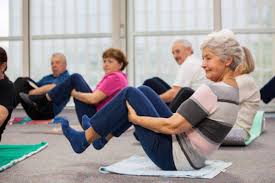
Osteoporosis is a common concern for many of our older clients we see at Central Performance. It is a condition where our bones start to lose density and become more brittle and susceptible to fractures. It is commonly associated with ageing and more prevalent in women, particularly those going through menopause. It is estimated that 1.2 million Australians have osteoporosis while a further 6.3 million have osteopenia (mild bone loss but below the threshold to be considered osteoporotic).
Like the rest of our body, bones are constantly being broken down (resorption) and regenerated (synthesised). In most cases these two processes match each other and we end up with little or no net change in our bone mineral density. However, in people with osteopenia or osteoporosis, the process of resorption (lead by cells called osteoclasts) occurs at a greater rate than bone synthesis can occur (lead by cells called osteoblasts). This leads to a reduction in bone mineral density and osteoporosis.
Osteoporosis can be caused by a number of factors, both modifiable and non-modifiable. Genetics play a large role in the likelihood of developing osteoporosis and is obviously not modifiable. Hormone levels can also play a role in the development of osteoporosis, in particular low levels of oestrogen in women and androgen in men. This is why women are susceptible to developing osteoporosis during menopause when oestrogen levels drop and why men who are undergoing androgen-deprivation therapy for prostate cancer are also at increased risk. More modifiable risk factors for osteoporosis are low levels of calcium and vitamin D. Low levels of weight bearing exercise is also a modifiable risk factor and is where exercise physiology can help in the management of osteoporosis and osteopenia.
As mentioned earlier, as a living tissue bone is constantly being resorbed and synthesised. Bone synthesis occurs in response to the amount of load and stress being placed on the bone. Unfortunately, as we get older we reduce our levels of exercise and in particular our levels of fast-paced, high impact and weight bearing exercise. This reduces the stimulus on the bone that promotes bone synthesis. It is by appropriately increasing levels of weight bearing and high impact exercise that exercise physiology helps manage osteoporosis.
Weight bearing exercise helps stimulate bone synthesis by increasing the load placed on the skeletal system. However, it’s not the external load itself that stimulates bone synthesise but the pull of the muscles on the bone during weight bearing exercise. As the muscles contract to move the weight they place significant load and stress on the bone. This load on the bones stimulate osteoblasts to begin bone synthesis.
In order to elicit strong enough muscle contractions to stimulate the osteoblasts a heavy weight is required. This is why cardio exercise such as running is often not enough to help prevent or manage osteoporosis. It is also why we really encourage our clients at Central Performance with osteopenia and osteoporosis to begin weight training. Using weights such as dumbbells, barbells and kettlebells help to promote high levels of muscle contraction which lead to positive levels of load on the bones.
The other form of exercise that helps to stimulate bone synthesis is high impact exercise. These are exercises such as jumping and sprinting which result in both lots of force being produced by the muscles as well as high levels of impact with the ground. The impact and ground reaction forces from jumping exercises place a significant amount of load on the bones. Just as important as the impact is the amount of force the muscles produce during the jumping and landing phases of the exercises. Both phases require the muscles to produce a lot of force very quickly which is a fantastic stimulus for bone synthesis. While jumping and impact exercises are fantastic in the management of osteoporosis, they are exercises that lots of clients with osteoporosis have some fear and lack of confidence with. Therefore, they are something we introduce slowly during our exercise physiology sessions at Central Performance.
At Central Performance we individualise each exercise physiology program for our clients including for those clients with osteoporosis. Our programs are individualise depending on the clients current abilities, their experience and confidence with exercise and resistance training and their goals. For clients with osteoporosis we begin by getting them confident using weights and doing movements such as deadlifts, squats and lunges. These movements require lots of muscles to work very hard and are excellent to help with the management of osteoporosis. Once our clients are confident with these exercises and are able to use decent amounts of weight with them we then introduce jumping exercises.

